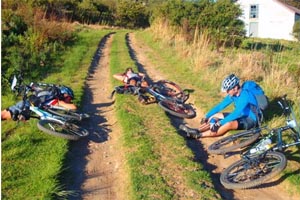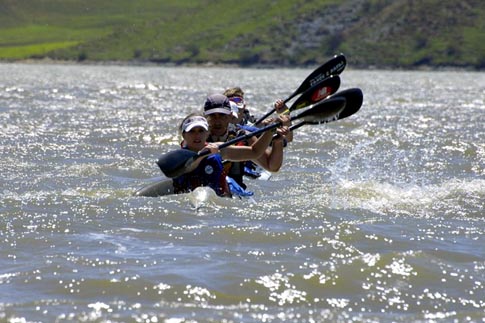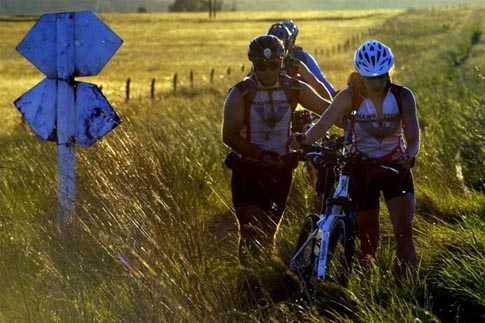 We were fired up and ready to go, the first hike leg was great we had decided to do all CP’s and all the OP’s it was easy going nice weather beautiful scenery, lots of game and birdlife. We scored a BarOne for getting wet at 4.15 am then went for the furthest OP. Except for OP 5 which we later discovered was slightly misplaced we got them all got back to transition and headed out on MTB leg.
We were fired up and ready to go, the first hike leg was great we had decided to do all CP’s and all the OP’s it was easy going nice weather beautiful scenery, lots of game and birdlife. We scored a BarOne for getting wet at 4.15 am then went for the furthest OP. Except for OP 5 which we later discovered was slightly misplaced we got them all got back to transition and headed out on MTB leg.
The MTB was straight forward and enjoyable we ran out of track but the veld was rideable, we overshot the ideal spur to come of the mountain and ended up with a hike a bike down a mountain back to the main road. By now the wind was pumping properly and we arrived at the paddle leg to the great sight of waves. We opted to collect the first two points on foot which was a mistake, as we got clift in and I took a swim across the dam ran around the corner and collected the point.
We headed back and got going in the canoes with Erik in the motor boat anxiously waiting for some action shots if we fell out. We did not and aced the paddle making up serious time.
Most other teams have exciting stories to tell of swimming, sinking canoes and very long hiking legs.
We transitioned onto MTB and set out into a howling headwind in the heat of the day and some serious climbs to make things more interesting. By this stage Rob was taking serious strain and thought his blood sugar was low, infract it was high way to high and he took on even more sugar thinking it would help. Rob was in a bad way I had been towing him which was also taking a toll on me. We overshot a CP Greg and Amy went back while Rob and I followed them at a much slower pace.
We stopped to rest and Rob was getting rid of all he had eaten he was not in a good place, Rehidrate had no effect. I was worried and feeling helpless, Level 1 first aid does not equip one for an event of this magnitude.
Greg and Amy returned, I made the call to skip the OP’s and head for transition where we would re evaluate. We were all hopefull that Rob would recover and we could continue with the race. It was not to be he had a sugar count of 18 instead of 8 and need first one and later another insulin injection as well as 12 hours rest and sleep to start feeling well.
Rob, you pushed well beyond the call and you gave us a big scare but I understand and think you are a star. We will learn how to manage diabetes under race conditions and race again soon. To Amy and Greg you both have a bright AR future and will go far well done! I realy enjoyed racing with all of you.
Lessons learnt.
1) Take the time to understand your team mates special medical requirements.
2) Use your emergency phone!! I could have called for help and advice but did not choosing to drag Rob to Transition in the hope that we could race on. This time we were lucky it all turned out fine.
3) It is only a race! If you or a team mate are stuffed bail you can race again another day. I am not talking about a blister or two here. The hard part is when is enough enough!
4) If you have a medical condition seek out others who have the same condition and ask for advice.
5)It is probable that Rob’s insulin level was to low to allow the sugars to be metabolized, it is a good idea to measure during a race and then act do not guess!
6) In a race where the final positions are based on CP’s then OP’s then Time it should be logical that it is more important to collect the CP’s and the OP’s than to go as fast as possible. Perhaps if we were going slower Rob would have been fine?
7) Put effort into training your weakest discipline and it will reward you.
8) Find out how your body reacts to ultra distance under training conditions first.
Thank you for reading this race report I hope you can benefit from it.
Best regards, Alec
Team Hawkstone | Alec Avierinos, Gregory Avierinos, Amy Witherden, Robert Crichton | Balele Tracks AR, Wakkerstroom. 13 November 2010


yeah – unlucky Rob, Alec and team. Looking forward to seeing you out and about again.
I think Rob just had a bad day. The problem with AR is there is a lot we can’t control. Unpredictibility is bad for diabetics.
There are many things that can throw you off. Insulin sensitivity changes over long races, insulin could go off in the heat, you eat something you’re not used to and it doesn’t have the carb’s you were expecting, your stomach gets upset and won’t move the carbs through delaying blood sugar response, a 12 hour stage turns into a 24 hour slog and you don’t pack enough food. It can be difficult to keep it under control. But it’s possible.
A blood sugar reading of 18 wouldn’t flatten someone, so something else was happening too. Rob’s got lots of endurance sport experience and he’s a great athlete. I’m sure he knows as much as I do about dealing with diabetes in races. He’s probably trying to figure out what went wrong. And he’ll know how to stop it happening again.
We have to learn from it. We have team-mates to support us and reduce the risk, but we also run the risk of dissapointing them if something goes wrong. Most of the time you wouldn’t notice we’re diabetic. If you do hopefully its because we’re being proactive to hold it all together. And if it goes wrong our teammates are there to look after us.
Unlucky Rob!
Alex Pope is also diabetic and over recent years he has been learning how to deal with it under different conditions and racing intensities. During races he takes blood sugar readings a good number of times to monitor what is happening; it’s important not to go too low or too high. High intensity races are almost easier because he just keeps munching. It is so worth stopping for those few minutes to test.
Gets better with practise 😉